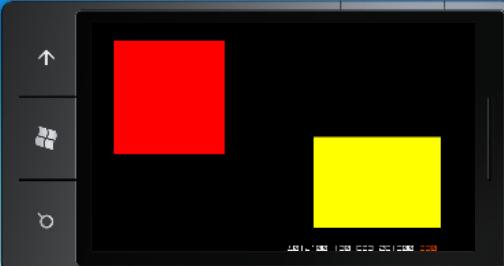俺们都知道,智能手机可以通过旋转手机来改变屏幕的显示方向,更多的时候,对于屏幕方向的改变,我们要做出相应的处理,例如,当手机屏幕方向从纵向变为横向时,可能要重新排列页面上的控件以适应显示区域的变化。
要使页面支持旋转,要把PhoneApplicationPage的SupportedOrientations属性改为PortraitOrLandscape,然后可以通过定义OrientationChanged事件来处理布局。形如:
<phone:PhoneApplicationPage
..............
SupportedOrientations="PortraitOrLandscape"
Orientation="Portrait"
OrientationChanged="PhoneApplicationPage_OrientationChanged">
- 1.
- 2.
- 3.
- 4.
- 5.
一、Grid控件的处理。
<phone:PhoneApplicationPage
x:Class="Sample_PageDir.Page1"
xmlns="http://schemas.microsoft.com/winfx/2006/xaml/presentation"
xmlns:x="http://schemas.microsoft.com/winfx/2006/xaml"
xmlns:phone="clr-namespace:Microsoft.Phone.Controls;assembly=Microsoft.Phone"
xmlns:shell="clr-namespace:Microsoft.Phone.Shell;assembly=Microsoft.Phone"
xmlns:d="http://schemas.microsoft.com/expression/blend/2008"
xmlns:mc="http://schemas.openxmlformats.org/markup-compatibility/2006"
FontFamily="{StaticResource PhoneFontFamilyNormal}"
FontSize="{StaticResource PhoneFontSizeNormal}"
Foreground="{StaticResource PhoneForegroundBrush}"
mc:Ignorable="d" d:DesignHeight="768" d:DesignWidth="480"
shell:SystemTray.IsVisible="True"
SupportedOrientations="PortraitOrLandscape"
Orientation="Portrait"
OrientationChanged="PhoneApplicationPage_OrientationChanged">
<Grid x:Name="layoutRoot">
<Grid.RowDefinitions>
<RowDefinition Height="Auto" />
<RowDefinition Height="Auto" />
</Grid.RowDefinitions>
<Grid.ColumnDefinitions>
<ColumnDefinition Width="Auto" />
<ColumnDefinition Width="Auto" />
</Grid.ColumnDefinitions>
<Image x:Name="img" Source="http://gubapic.eastmoney.com/member/e68/e681999/e68199920091216131540.jpg" Stretch="UniformToFill" Width="270" Grid.Row="0" Grid.Column="0" />
<TextBlock x:Name="txtBlock"
Grid.Row="1"
Grid.Column="0"
FontSize="70"
Margin="28">
<Run Foreground="Coral">信春哥</Run>
<LineBreak/>
<Run Foreground="Yellow">唱情歌</Run>
<LineBreak/>
<Run Foreground="SkyBlue">不挂科</Run>
</TextBlock>
</Grid>
</phone:PhoneApplicationPage>
- 1.
- 2.
- 3.
- 4.
- 5.
- 6.
- 7.
- 8.
- 9.
- 10.
- 11.
- 12.
- 13.
- 14.
- 15.
- 16.
- 17.
- 18.
- 19.
- 20.
- 21.
- 22.
- 23.
- 24.
- 25.
- 26.
- 27.
- 28.
- 29.
- 30.
- 31.
- 32.
- 33.
- 34.
- 35.
- 36.
- 37.
- 38.
- 39.
- 40.
页面主要有两个控件,一个用于显示图片,一个用于显示文本信息,通过事件处理代码来相应改变两个控件的布局。
private void PhoneApplicationPage_OrientationChanged(object sender, OrientationChangedEventArgs e)
{
// 如果是横向的
if (e.Orientation == PageOrientation.Landscape ||
e.Orientation == PageOrientation.LandscapeLeft ||
e.Orientation == PageOrientation.LandscapeRight)
{
Grid.SetColumn(this.img, 0);
Grid.SetRow(this.img, 0);
Grid.SetRow(this.txtBlock, 0);
Grid.SetColumn(this.txtBlock, 1);
}
// 如果是纵向
else if (e.Orientation == PageOrientation.Portrait ||
e.Orientation == PageOrientation.PortraitDown ||
e.Orientation == PageOrientation.PortraitUp)
{
Grid.SetColumn(this.img, 0);
Grid.SetRow(this.img, 0);
Grid.SetRow(this.txtBlock, 1);
Grid.SetColumn(this.txtBlock, 0);
}
else
{
Grid.SetColumn(this.img, 0);
Grid.SetRow(this.img, 0);
Grid.SetRow(this.txtBlock, 1);
Grid.SetColumn(this.txtBlock, 0);
}
}
- 1.
- 2.
- 3.
- 4.
- 5.
- 6.
- 7.
- 8.
- 9.
- 10.
- 11.
- 12.
- 13.
- 14.
- 15.
- 16.
- 17.
- 18.
- 19.
- 20.
- 21.
- 22.
- 23.
- 24.
- 25.
- 26.
- 27.
- 28.
- 29.
- 30.
按F5运行程序,默认的屏幕方向是纵向的,如下图所示:
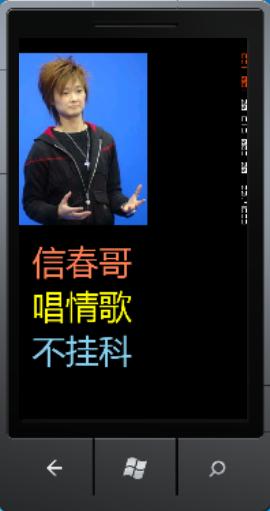
好,现在,我们把屏幕旋转一下,看看会怎么样。
别走开,下页更精彩
#p#
二、StackPanel控件的处理。
<phone:PhoneApplicationPage
x:Class="Sample_PageDir.Page2"
xmlns="http://schemas.microsoft.com/winfx/2006/xaml/presentation"
xmlns:x="http://schemas.microsoft.com/winfx/2006/xaml"
xmlns:phone="clr-namespace:Microsoft.Phone.Controls;assembly=Microsoft.Phone"
xmlns:shell="clr-namespace:Microsoft.Phone.Shell;assembly=Microsoft.Phone"
xmlns:d="http://schemas.microsoft.com/expression/blend/2008"
xmlns:mc="http://schemas.openxmlformats.org/markup-compatibility/2006"
FontFamily="{StaticResource PhoneFontFamilyNormal}"
FontSize="{StaticResource PhoneFontSizeNormal}"
Foreground="{StaticResource PhoneForegroundBrush}"
SupportedOrientations="PortraitOrLandscape"
OrientationChanged="PhoneApplicationPage_OrientationChanged"
Orientation="Portrait"
mc:Ignorable="d" d:DesignHeight="768" d:DesignWidth="480"
shell:SystemTray.IsVisible="True">
<phone:PhoneApplicationPage.Resources>
<Style TargetType="TextBlock">
<Setter Property="FontSize" Value="46"/>
</Style>
</phone:PhoneApplicationPage.Resources>
<StackPanel x:Name="pl">
<TextBlock Text="文本一"/>
<TextBlock Text="文本二"/>
<TextBlock Text="文本三"/>
</StackPanel>
</phone:PhoneApplicationPage>
- 1.
- 2.
- 3.
- 4.
- 5.
- 6.
- 7.
- 8.
- 9.
- 10.
- 11.
- 12.
- 13.
- 14.
- 15.
- 16.
- 17.
- 18.
- 19.
- 20.
- 21.
- 22.
- 23.
- 24.
- 25.
- 26.
- 27.
后台事件处理代码。
private void PhoneApplicationPage_OrientationChanged(object sender, OrientationChangedEventArgs e)
{
if (e.Orientation == PageOrientation.Landscape ||
e.Orientation == PageOrientation.LandscapeLeft ||
e.Orientation == PageOrientation.LandscapeRight)
{
this.pl.Orientation = System.Windows.Controls.Orientation.Horizontal;
}
else
{
this.pl.Orientation = System.Windows.Controls.Orientation.Vertical;
}
}
- 1.
- 2.
- 3.
- 4.
- 5.
- 6.
- 7.
- 8.
- 9.
- 10.
- 11.
- 12.
- 13.
运行,默认方向是纵向。
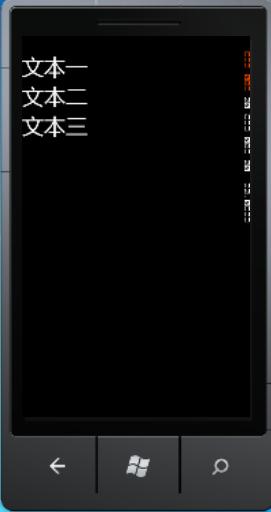
把屏幕旋转后。
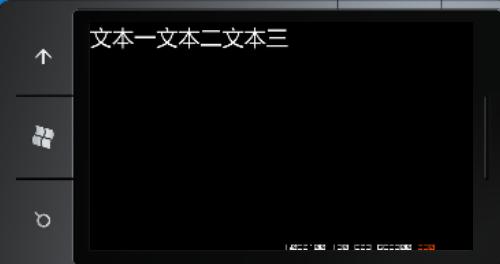
三、Canvas控件的处理。
<phone:PhoneApplicationPage
x:Class="Sample_PageDir.Page3"
xmlns="http://schemas.microsoft.com/winfx/2006/xaml/presentation"
xmlns:x="http://schemas.microsoft.com/winfx/2006/xaml"
xmlns:phone="clr-namespace:Microsoft.Phone.Controls;assembly=Microsoft.Phone"
xmlns:shell="clr-namespace:Microsoft.Phone.Shell;assembly=Microsoft.Phone"
xmlns:d="http://schemas.microsoft.com/expression/blend/2008"
xmlns:mc="http://schemas.openxmlformats.org/markup-compatibility/2006"
FontFamily="{StaticResource PhoneFontFamilyNormal}"
FontSize="{StaticResource PhoneFontSizeNormal}"
Foreground="{StaticResource PhoneForegroundBrush}"
SupportedOrientations="PortraitOrLandscape"
Orientation="Portrait"
OrientationChanged="PhoneApplicationPage_OrientationChanged"
mc:Ignorable="d" d:DesignHeight="768" d:DesignWidth="480"
shell:SystemTray.IsVisible="True">
<Canvas x:Name="cv">
<Rectangle x:Name="rect1"
Width="232"
Height="238"
Fill="Red"
Canvas.Left="88"
Canvas.Top="88"/>
<Rectangle x:Name="rect2"
Height="192"
Width="275"
Fill="Yellow"
Canvas.Top="268"
Canvas.Left="155"/>
</Canvas>
</phone:PhoneApplicationPage>
- 1.
- 2.
- 3.
- 4.
- 5.
- 6.
- 7.
- 8.
- 9.
- 10.
- 11.
- 12.
- 13.
- 14.
- 15.
- 16.
- 17.
- 18.
- 19.
- 20.
- 21.
- 22.
- 23.
- 24.
- 25.
- 26.
- 27.
- 28.
- 29.
- 30.
- 31.
后台代码。后台代码。
private void PhoneApplicationPage_OrientationChanged(object sender, OrientationChangedEventArgs e)
{
if (e.Orientation== PageOrientation.Landscape||e.Orientation== PageOrientation.LandscapeLeft||e.Orientation== PageOrientation.LandscapeRight)
{
Canvas.SetTop(this.rect1, 37);
Canvas.SetLeft(this.rect1, 46);
Canvas.SetTop(this.rect2, 240);
Canvas.SetLeft(this.rect2, 462);
}
else
{
Canvas.SetTop(this.rect1, 88);
Canvas.SetLeft(this.rect1, 88);
Canvas.SetTop(this.rect2, 268);
Canvas.SetLeft(this.rect2, 155);
}
}
- 1.
- 2.
- 3.
- 4.
- 5.
- 6.
- 7.
- 8.
- 9.
- 10.
- 11.
- 12.
- 13.
- 14.
- 15.
- 16.
- 17.
看看效果。看看效果。
纵向。
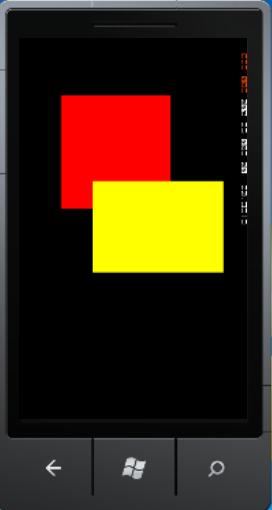
横向。
